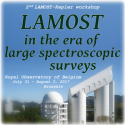Speaker
Mrs
Ruyuan Zhang
(Beijing normal university)
Description
Massive photometric data of different parts of the galaxy were obtained by covering 16 campaigns around the eclipse through K2, the second phase of the Kepler mission. Unlike the Kepler space telescope K2 mainly focuses on the data of more bright stars. Applying the ground based survey it is way more competent to observe those bright stars. LAMOST, a very influential ground based facility initiated the "LAMOST-K2 " project at the end of 2015. Due to the fact that LAMOST is located at the northern hemisphere, only 8 K2 field can be observed by it. By analyzing the statistics of the LAMOST stellar parameters, some special targets in the LAMOST-K2 field are found: around 65 samples of those have high radial velocity (|Vr| > 300 km/s), 2061 stars were identified as metal poor candidates ([Fe/H]<-1 dex) and 138 stars were recognized as very metal poor candidates ([Fe/H]<-2 dex). Among more than 10 K2 fields, campaign one, which lies in the northern galactic cap, never observed high precise huge photometric data and spectral before. Calibration of the input catalog of K2 has been done by combining the large surface data obtained from the asterseimic method with data of LAMOST atmospheric parameters. Finally by using the stellar parameters and the location in the Hertzsprung-Russel diagram classification of the red giant in K2-C1 field is also done in this work.
Primary author
Mrs
Ruyuan Zhang
(Beijing normal university)
Co-author
Prof.
JIANNING FU
(BEIJING NORMAL UNIVESITY)

